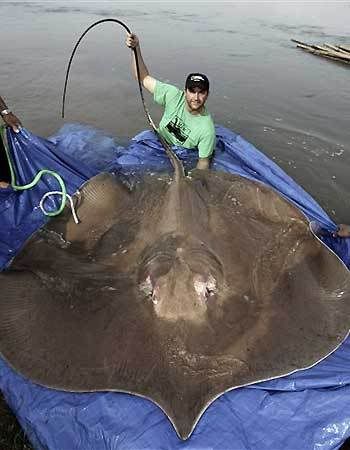
SAMUT SONGKRAM, Thailand — Rushing across a temple parking lot, British angler Rick Humphreys yells, "We've got a fish."
He jumps into a small motorboat on the Maeklong River in time to see Wirat Moungnum bring the prize to the surface — a rare, giant freshwater stingray that weighs as much as 44 pounds.
It bursts through the murky water exposing a soft, white underbelly the size of a trash can lid. The crew scrambles to string a rope through its gill-like slits and wrap a towel around its 5-foot-long tail that has a venomous barb.
"It's a start," Humphreys says almost apologetically. The specimen is a tenth of the size of the largest rays. "There are a lot bigger ones than that."
Humphreys is serving as a guide for American biologist Zeb Hogan, who is on a worldwide quest for the largest freshwater fish.
Hogan, 34, has heard the stories of Cambodian fishermen catching rays that weighed over 1,100 pounds with wingspans of 14 feet. But so far, they are just stories. If he can confirm them, he could eclipse the world record now held by the Mekong giant catfish.
"It could be the largest fish in the world and we know next to nothing about it," Hogan says. "I've spent five years on the Mekong looking for rays and only saw two or three. They were nowhere near the size I'd heard about."
Hogan's quest is part of the Megafishes project financed by the National Geographic Society.
The three-year project, which started in 2006, aims to document and protect freshwater giants that weigh at least 200 pounds or measure 6 feet long. The project will take Hogan to 14 freshwater systems on six continents, including the Mekong, Nile, Mississippi and Amazon rivers.
Time is running out for many of the species. The Chinese paddle fish and the dog-eating catfish in Southeast Asia are on the brink of extinction because of pollution, overfishing and dam building. In the Yangtze, where the Three Gorges Dam is a serious threat, Chinese paddle fish haven't been caught since 2003.
"Of the two dozen or so species of giant fish, about 70 percent are threatened with extinction," says Hogan, an assistant research professor at the University of Nevada-Reno.
Hogan dresses like a tourist with a baseball cap and shorts and has the boyish enthusiasm of an explorer. He spends much of the year searching for these large fish.
So far, he has focused mostly on Asia, where he once traveled 36 hours by road to catch the taimen in Mongolia. He just returned from Bhutan, where he scoured the river canyons for mahseer, which can only be caught by the country's monarch.
Hogan said he was drawn to the freshwater ray, known scientifically as Himantura chaophraya, because so little is known about it.
Listed as vulnerable by the International Union for Conservation of Nature, it is believed to be found in rivers from Thailand to northern Australia. Scientists only discovered it 18 years ago, and its population is unknown.
"I have so many questions about this stingray," Hogan says. "Is it truly a freshwater species? Where does it breed? What are its migratory patterns?"
Hogan spent the past few years on the Mekong in a futile effort to catch rays, because the nets of Cambodian fishermen were no match for them. Rays also are nearly impossible to spot, since they spend much of their time scrounging for small fish, shrimp, crabs and mollusks that live on the bottom of these muddy rivers.
A few months ago, Hogan got wind of big rays being caught and released by Humphreys' company FishSiam in Thailand. Unlike the Cambodian fishermen, FishSiam uses modern rods and reels used to catch other big game fish. At first he was skeptical, then excited.
Humphreys seems an unlikely partner in Hogan's quest. With his beady eyes and bald head, Hogan looks the part of bouncer, and his thick Cockney accent can be hard to understand. He has no scientific training.
But he knows how to fish, and his team's success in catching stingrays is almost unmatched in Thailand. Just in the past year, Humphreys and his partner, Wuttichai Khuensuwan, have caught 40 rays on the Ban Pakong and Maeklong Rivers, the largest weighing in at 485 pounds.
Humphreys, who got his start catching carp in West London gravel pits, says he prefers stingrays because of their fight. They routinely break fishing lines, he says, and one took 15 of his men about six hours to bring to the surface.
"Their strength is legendary," he says. "When you see them in the flesh, it is quite humbling."
Catching a ray can be dangerous, he says, especially before its tail has been neutralized. "Crocodile Hunter" Steve Irwin was killed by a stingray barb in 2006, and a Florida man was critically injured that same year when struck in the chest by a ray's barb.
Wuttichai Kuachareonsri, a member of Humphreys' crew, stopped fishing for a year after he was stung in the leg by a ray barb. "I never have felt pain like that," he says. "It really frightened me."
On his fishing trip with Hogan, Humphreys boasts about "monsters" below the tranquil river and insists it is a matter of time before his team lands a world record ray.
The anglers head to the Ban Pakong and Maeklong rivers just two hours outside Bangkok, winding their way past office towers, Buddhist temples and busy highways. Fish farming pens dot the riverbanks and sounds of construction and puttering boats echo across the water.
Both spots have given up rays in the past. But on the their first day on the Ban Pakong, the fishermen come up empty. Humphreys blames the heavy rains that have swollen the river.
The next day, they have better luck on the Maeklong.
The rod bends almost into the water, and Wirat struggles for almost a half hour as the ray dives under the boat and across the bow.
It finally is brought to the surface, revealing its big bulging eyes and dark, coarse skin. Its tail alone is 12 feet long.
Hogan says catching such a big ray so close to a big city is a sign the species is thriving despite pollution. He is awaiting government permission to launch a two-year study to catch and tag 20 or 30 more rays to better understand their movements.
With that data, Hogan is hoping to do what he has done for the Mekong giant catfish, once almost fished to extinction. Hogan's work helped establish its endangered status and prompted authorities in Laos and Thailand to limit total catches to four a year.
WWF freshwater biologist Chavalit Vidthayanon, who discovered a smaller ray species in Thailand four years ago, agreed more research was needed to better understand the health of the big fish.
"We need to know its exact population and habitat so we can work on conservation and find ways to better protect them," he said.
For the easygoing Hogan, the research could help end what has become an epic journey to find "the king of the river."
"We're getting close to the record and I'm very confident that a fish of record size existed," he says. "The question is whether it still exists."
http://www.foxnews.com/story/0,2933,386652,00.html





![1021 [smilie=1021.gif]](./images/smilies/1021.gif)


